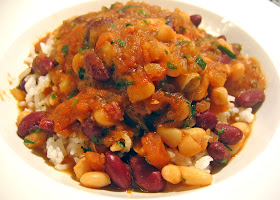The last time this event took place I remember seeing loads of blogs with photos of their postcards, so this time I decided to join in the fun.
The theme was St Valentine’s but of course I muddled this up and made a kitsch Australiana postcard instead. I know, I am a bit of a git but since it was Australia Day I was feeling the 'Aussie'.
I have sent my little postcard off to an undisclosed location somewhere in the world and hopefully some lovely blogger will get it and feel happy.
Now . . . I wonder who sent me a card?
~ ~ ~ ~ ~ ~ ~ ~
Since it’s summer here, and the wedding is fast approaching, I’ve become a bit of a salad fiend. Lately I’ve made tabouleh, Cypriot potato salad, Moroccan carrots, lentil salad, chasoba noodle salad and now fattoush.
Fattoush is a Lebanese salad, meaning “moistened bread”. This refers to the fried or toasted pita bread providing the salad with so much crunch but which also absorbs the lemon juice and olive oil dressing.
Fattoush is eaten all over the Middle East and has a robust, tangy flavour that comes from the sumac, a berry that's dried and ground into a sour spice powder.
I love fattoush because it’s so flavoursome and yet so fresh and light. It makes a seriously easy summer dinner and it a great way to use up stale pita bread.
Fattoush
Recipe from Gourmet Traveller ‘Modern Salads’. Serves 8.
Ingredients:
1 cup olive oil, for frying
2 pieces Lebanese bread, quartered
500g grape or cherry tomatoes, halved
2 Lebanese cucumbers, finely chopped
1½ cups [loosely packed] flat-leaf parsley, finely chopped
1½ cups [loosely packed] mint, finely chopped
4 radishes, halved and thinly sliced
4 green onions, thinly sliced
1 red capsicum (pepper), finely chopped
1 tablespoon sumac
½ cup extra virgin olive oil, for dressing
4 tablespoons lemon juice
Method:
1. Heat olive oil in a large saucepan over a medium heat. When hot add half the Lebanese bread and fry until golden. Drain on absorbent paper then repeat with remaining bread.
2. Combine tomatoes, capsicum, cucumber, parsley, mint, radishes and green onions in a large bowl and stir to combine.
3. Coarsely break fried bread and toss through salad.
4. Sprinkle in the sumac, drizzle some olive and lemon juice and toss gently to combine.
Tags: morsels and musings food blog food and drink australia recipes fattoush salad pita bread lebanon lebanese lebanese recipeslebanese food lebanese cuisine vegetarian vegetarian recipesvegetarian food vegetarian cuisine











































